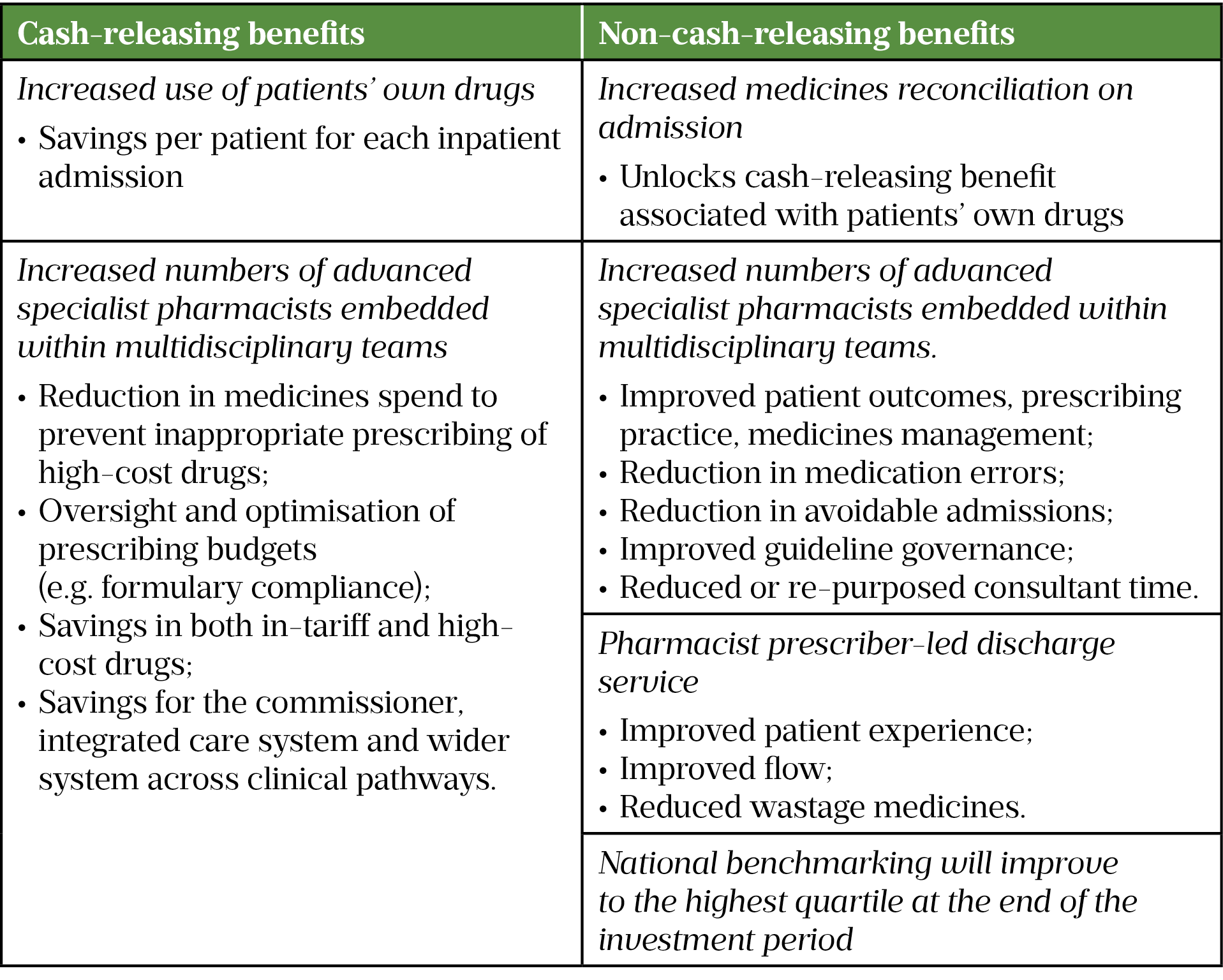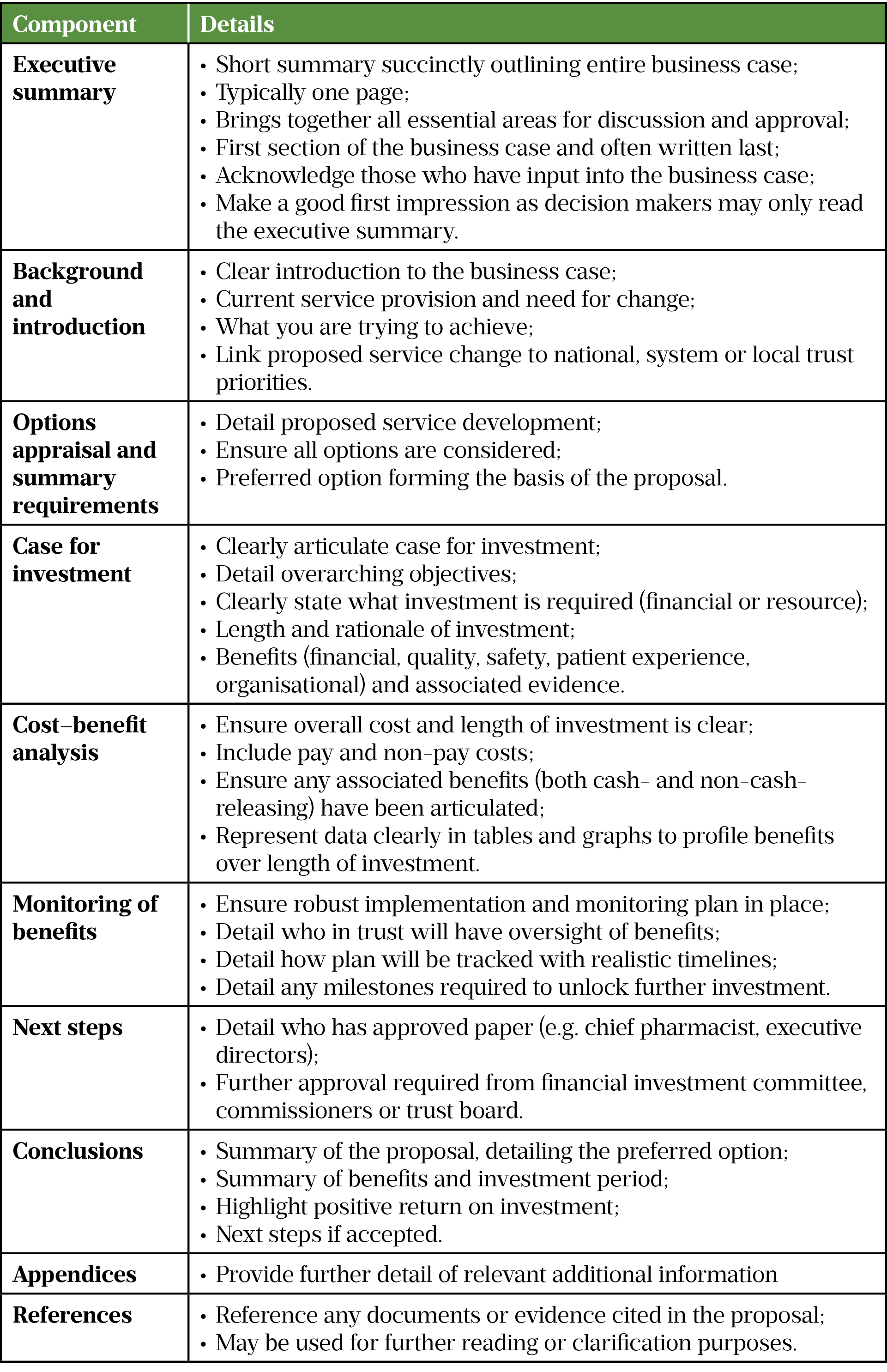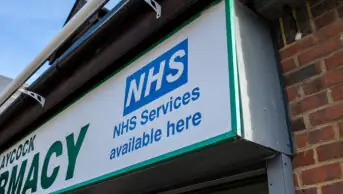
Shutterstock.com
After reading this article, you should:
- Know what a business case is;
- Understand all the necessary elements of a business case for a new pharmacy service;
- Be able to write a comprehensive proposal;
- Know the difference between a good business case and one lacking sufficient detail.
Pharmacy teams may want to develop or implement new services in their organisations to realise quality, safety and operational benefits and financial efficiencies, or to improve the patient experience.
In the current climate, where all NHS organisations need to ensure financial sustainability, all investments in new services must be prioritised based on local, national or system priorities[1]. Pharmacy teams must therefore be able to write successful business cases to justify investment within pharmacy services.
A business case is a ‘structured economic argument for change, development or investment, appraised against all other options and includes a calculation of costs and benefits together with a plan for realisation’[2]. It usually takes the form of a structured, formal proposal and outlines all of the evidence required for the stakeholders within an organisation to make an informed, objective decision on whether a service development will offer service-specific benefits and value for money.
Pharmacy teams develop business cases to secure approval, additional resources or investment. They may, for example, want investment in the workforce based on service changes (e.g. adding a consultant pharmacist), to address capacity challenges (e.g. in a pharmacy homecare service) or to justify investment in digital technology and automation (e.g. new pharmacy robot or electronic prescribing and medicines administration system) to improve medicines safety, processes and efficiency.
Business cases will often need to be formally presented and signed off internally by the chief pharmacist, and possibly others, before progression to the trust’s board for executive sign off (if above the threshold for sign-off by executive directors).
Writing a business case for the first time can be time-consuming and complex, and may feel daunting. Using the example of a new business case for a pharmacy workforce plan, the purpose of this article is to ensure that all pharmacy staff are familiar with what a successful proposal should include and are able to produce and deliver well-structured business cases when required.
1. Writing a proposal
It is important to understand which local policies to follow and who to consult with. Your organisation should have a template for justifying new service developments, describing the level of detail required proportional to the size of the investment required, and which individuals or committees will be required to sign off the case.
Involving the right people is essential — this could be the chief pharmacist, division or service manager, finance manager, or lead clinician — as they will be able to help prepare the proposal. You may also need to seek approval from an executive sponsor before being able to present the case to the trust board.
It is important to submit a business case in the correct format. Failing to do so could mean it is returned or rejected out of hand. You could follow a local generic template, or draft your own, including the components described in Box 1. Complete all applications fully and include every piece of requested information to prevent the case being returned for further revisions.
Box 1: Top tips for preparing a business case
- Write in the template and style your audience requires;
- Keep it clear and concise — use correct language that minimises jargon;
- Communicate all the facts clearly — this provides evidence you have done your homework;
- Ensure the reader clearly understands your vision and what you want to achieve;
- Make your writing interesting as stakeholders will need to read it;
- Ensure the ask to the organisation is clear and aligns with the strategic direction of the trust;
- Demonstrate any benefits clearly — financial, quality, safety or operational efficiencies;
- Demonstrate how any benefits will be realised within realistic timelines;
- Clearly highlight any risks and potential mitigations;
- Ensure financial costs/benefits have been validated by the finance team[3].
2. Establish a need
A business case should begin by:
- Providing a background to the proposed service;
- Describing the current service provision;
- Outlining the overarching objectives — why is there need for investment?
When thinking about pharmacy workforce, it is important to review the current establishment and identify other workforce gaps using a validated tool (e.g. Royal Stoke Pharmacy Workforce Calculator) and to benchmark against trusts of similar size and complexity[4].
It is also important in any case to include an options appraisal, incorporating all the different options for service delivery and the potential benefits (see Figure)[2].The preferred option should then form the basis of the proposal.

3. Ensure the proposal is linked to national and local priorities
Any successful case for investment should demonstrate that it fits into the strategic priorities of the pharmacy department and the overall strategic direction of the organisation.
The business case should be placed in either a local or a national context and aligned to the priorities of the commissioners (e.g. NHS England and Improvement, local clinical commissioning group or host integrated care system) and, ultimately, the needs of the local population. For example, the benefits of increased numbers of specialist clinical pharmacists have been well articulated in the literature, which should help to justify investment. The Carter Report (2016), Productivity in NHS Hospitals, recommended that NHS trusts deploy more clinical pharmacists, including pharmacist prescribers, and use them to drive value from the £6.7bn that NHS hospitals spend on medicines each year[5].
The business case should also show overall value for money. For instance, value for money could be achieved through VAT savings (e.g. homecare service or outsourced pharmacy), meaning a new service could essentially fund itself.
Although variation in healthcare can often be acceptable and desired (e.g. introducing innovations in treatments or care), addressing unwarranted variation is a vital part of any case. Unwarranted variation can have harmful consequences for service users[6]. For example, not having the correct staffing establishment and skills mix for a pharmacy department could lead to variation in the quality of pharmacy services offered, and the service being unable to meet capacity and demand. This would drive the need for the change articulated within the business case.
It is important to put any business case into context and to articulate if the case is linked to a national recommendation or standard (e.g. Care Quality Commission inspection, National Institute for Health and Care Excellence [NICE] guideline, NHS England service specification, Getting it Right First Time review, peer standards or national benchmarks). The organisation and commissioners will also look to national standards or current risks to inform what the service should deliver. Providing this context (e.g. number of pharmacists recommended per inpatient bed) and clearly articulating how the national recommendation will affect the local service will be important in securing investment in the proposed new service.
All pharmacy departments have risk registers, and pharmacy staff will have access to them to understand the areas of the most need and concern[7]. If your service development is linked to a known risk, either to patients or the organisation (e.g. increased length of stay or harm owing to poor medicines optimisation and/or delayed medications), this may influence the need for change and for taking the business case forward.
4. Include the best clinical evidence
The benefits documented within the proposal must be backed up by a clear evidence base and appropriate references (e.g. NICE guidance). When using evidence within a business case, the authors should consider the strength of that evidence. Using evidence correctly is paramount to presenting a compelling case — it can put into context for the reader the clinical evidence, quality or financial benefits proposed as a justification for supporting the case.
More on how to critically appraise evidence can be found here.
5. Document the benefits
A benefit can be defined as a measurable improvement resulting from change[8]. In any good business case, the benefits should be clearly identified and articulated, linking back to the strategic objectives. It needs to be clear to the decision makers what the value of investing in pharmacy services will be.
Benefits can be described as cash-releasing (financial) or non-cash-releasing (safety, quality, or patient experience)[8]. Cash-releasing benefits are economic benefits that can be expressed in monetary terms. Non-cash-releasing benefits are all about efficiencies and, although the value can often be expressed in monetary terms, these would not be removed from budgets. It is also important to articulate if the benefits are recurrent and likely to continue or non-recurrent and limited to a specific period.
Table 1 lists the benefits of a new workforce strategy designed to increase the headcount of pharmacy staff in a department[9]. It highlights the benefits that will have the biggest operational and/or financial impact.

6. Cost–benefit analysis
A business case must clearly describe the costs of the service and its value for money. Significant business cases will probably be assessed by the organisation’s director of finance and will need to be taken to a finance investment committee (or equivalent) prior to sign off. It is therefore crucial that any successful business case should clearly articulate the financial impact of the proposal (see Box 2 and Table 2)[9].
Box 2: Sample text outlining the financial impact of a proposal
For a cumulative investment of circa £2.66m over 4 years, there is a cash-releasing benefit of £2.15m and a non-cash-releasing benefit of £2.83m, with a net benefit of circa £2.32m over the 4-year period, as profiled in the table below.

7. Describe how to implement, monitor and assess the service
Ensure that the proposal includes a clearly articulated, robust plan for the successful implementation, monitoring and assessment of the service and associated benefits (both cash- and non-cash-releasing, as detailed in Table 2). The proposal should demonstrate how sustained investment year on year will lead to an improvement in the trust’s benchmarked position for pharmacy workforce against its peers.
Set realistic timescales for implementation and tracking (e.g. monthly over a four-year period), including specific milestones that would unlock further investment (e.g. need to recruit to all proposed positions annually). It may be necessary to run a small-scale pilot to prospectively evaluate the new change and the impact of the service.
The business case should also specify who in the organisation will track and have oversight of the benefits, and how often these will be reported. The finance team will typically track the cash-releasing benefits. The pharmacy team will typically track the non-cash-releasing benefits via audit against agreed metrics, using established quality-improvement methodology.
8. Be prepared to make a formal presentation
You should be prepared to present your case in a variety of different forums and to different stakeholders prior to sign off. Depending on the size of the investment, you may be required to present to a finance investment committee or trust board. It is important that your case is well prepared (see Table 3), succinct and easy to read[3,10]. You may want to prepare a short slide deck to support your pitch. Be clear on who the audience is and the level of detail they require.
Focus on communicating your case clearly, ensuring the decision makers understand what the service aims to achieve and the associated risks (if any) and benefits. Prepare thoroughly and try to anticipate potential questions — try to build these into the business case and your narrative to have the best chance of success. For example:
- How will you recruit the additional staff, recognising national challenges around workforce?
- How will this workforce plan affect neighbouring organisations/destabilise local system?
- What is your strategy for retention of staff?
- How will you ensure the benefits articulated are realised annually?
These resources on how to present data visually for a presentation and deliver effective talks and presentations may be useful to guide this.

Conclusion
If pharmacy staff wish to develop pharmacy services, they must be able to put together and present a successful business case. It is an unavoidable step in influencing decision makers and securing necessary funding.
Following the guidance in this article will ensure that your business case is as robust as possible, giving it the best chance of success.
- 1Integrating care: Next steps to building strong and effective integrated care systems across England. NHS England and NHS Improvement. 2020.https://www.england.nhs.uk/wp-content/uploads/2021/01/integrating-care-next-steps-to-building-strong-and-effective-integrated-care-systems.pdf (accessed May 2022).
- 2Your guide to building a business case. NHS Property Services. 2021.https://www.property.nhs.uk/media/3656/customer-guide-to-building-a-business-case.pdf (accessed May 2022).
- 3Guidance on completing a business case. Mersey Care NHS Trust. 2011.https://www.eprescribingtoolkit.com/wp-content/uploads/2020/04/Business-Case-Guidance.pdf (accessed May 2022).
- 4Bednall R, White S, Mills E, et al. Validation of a hospital clinical pharmacy workforce calculator: A methodology for pharmacy? Int. J. Clin. Pract. 2021;75. doi:10.1111/ijcp.13932
- 5Productivity in NHS hospitals. Department of Health and Social Care. 2016.https://www.gov.uk/government/publications/productivity-in-nhs-hospitals (accessed May 2022).
- 6Cripps M. What do we mean by ‘variation’ and when is it ‘unwarranted’? NHS RightCare. 2017.https://www.england.nhs.uk/rightcare/2017/01/04/matthew-cripps-3/ (accessed May 2022).
- 7MS Trust Guide to writing a strong business case. Multiple Sclerosis Trust. 2019.https://mstrust.org.uk/sites/default/files/MS%20Trust%20guide%20to%20writing%20a%20strong%20business%20case%20Sept%2019%20FINAL.pdf (accessed May 2022).
- 8Financial benefits of Personal Health Records. NHS Digital. 2021.https://digital.nhs.uk/services/personal-health-records-adoption-service/personal-health-records-adoption-toolkit/benefits-of-personal-health-records/financial-benefits-of-personal-health-records (accessed May 2022).
- 9Thakkar K, Soni V. Pharmacy Workforce Plan 2021–2026. University Hospitals Plymouth NHS Trust 2021.
- 10Carter H. How to write a robust business case for service development. Nursing Times 2017;:25–28.


